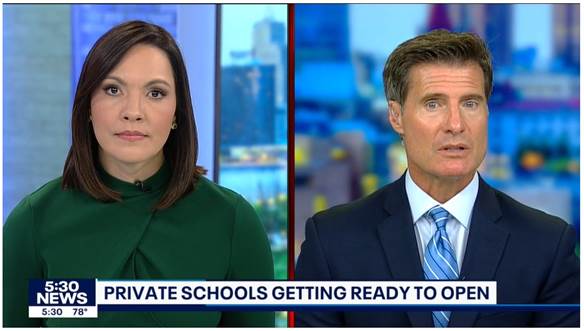At OAK, we’ve been spending a lot of time at the Capitol, talking with legislators and aides about the broken education system, Education Savings Accounts (ESAs), and what it will take to provide Minnesota parents with the freedom and resources to find the right schools for their kids.

In the Minnesota Senate, we are enormously grateful to Senator Rarick as well as Senators Coleman, Howe, Johnson, and Drazkowski who sponsored our legislation, SF 3435. The bill would allow Minnesota’s underserved students to apply for an ESA with over $7,000 to use at an eligible school of their choice. The money for the account would come from existing state education funds, not local property taxes.
The need for ESAs and more opportunities in education cannot be overstated.
In 2023, the Minnesota Department of Education reports 50% of all Minnesota’s public-school students were not reading at grade level. As there are over 860,000 students, that means 400,000+ students are not proficient in reading. The situation hardly improves by the time a student reaches high school as 48% of Minnesota’s sophomores are not proficient in reading. (10th grade is the last time reading proficiency is tested.)

As you can see, the decline in proficiency started well before COVID – by 2019, 40% of sophomores were not proficient in reading. The lockdowns merely accelerated the crisis.
The system as we know it today was built by and for the teachers’ unions, not the students. Changing it from within is nearly impossible at this point as it’s a closed loop with teachers’ union control from top to bottom.
The solution is to change the model.
As a state we believe that all children need an education, both for themselves and the good of the state. An education system that can only help half the students read proficiently, despite many Minnesota school districts spending $20,000 or more per student annually, must be reconsidered.
Naturally, with tens of billions of dollars at stake, the adults who benefit from the system don’t want change.
One of the more head-scratching arguments legislators have relayed to me, often originating from local superintendents or school board members, is that we cannot fund the students with ESAs as that will hurt the public schools.
Why would ESAs hurt the public schools? Because local education officials believe many parents would choose a different school if they had the resources and freedom to do so.
That is, perhaps, one of the worst arguments against ESAs and education freedom that I’ve ever heard.
Effectively the argument is an admission that parents and students are trapped in a failing education system that serves the adults, not the students, and that it should be maintained for the adults despite half of the students failing to read at grade level. Is that really what the students need, or the people of Minnesota desire?
Understandably, schools are often centers of community and older Minnesotans may have fond memories of their times in public schools. Unfortunately, things have changed.
The public schools you remember are not the same today. Over the decades, we have moved from thousands of small school districts and local schools to a highly centralized, incredibly well-funded, monolithic system bloated with mandates and regulations that tie the hands of far too many teachers and administrators.
It’s akin to a Soviet grocery store with bare shelves fighting against competition because it will lose customers.
If we want the young people of our state to have a chance at a good life, we cannot ignore the reality of the current education crisis in Minnesota. As uncomfortable as it may be, we must do what is best for the students, not the teachers’ unions.
Offering ESAs to students in need will bring changes, but they are not forced changes. Parents who feel that the local school isn’t doing the job will simply have the opportunity to find a school that will. Parents who are happy with their local schools will stay put.
Up to this point, the people who have had the freedom to choose the right school for their kids have been the affluent. Meanwhile, many lower-income families are trapped. They can’t afford to move, and they can’t afford to send their children to better schools. Instead, they must send them to the local school that is often dangerous and fails to educate their children.
The same goes for many other middle-class families, even those with two income-earners in the suburbs or rural Minnesota. Both parents must work to provide for the family, especially in our high-inflation economy. One parent can’t suddenly quit and homeschool the kids, nor do they have sufficient income to send the kids to a school that can successfully prepare their children for success.
Far too many school districts across the state have reading proficiency rates that are below 60% and a shocking number are below 50% and even 40%. These districts do not lack for funds, either. They’re spending anywhere from $17,000 to $30,000—or more—per student each year. And hundreds of thousands of kids are trapped in them.
Systems do not last forever. Indeed, as systems age they often become ineffective, bogged down by rules and bloat, existing for their own sake rather than the original mission.
We need to get back to that original mission of educating the next generation for their good and the good of the state. And because the system seems incapable of reforming itself and only focused on more and more funding, we must look at other viable models to achieve an educated public. ESAs are the most viable option, giving all parents an equal footing to find the best school, the right school, for their kids.
That’s the choice Minnesota must confront: Will we maintain a failed system for the sake of the adults, or will we be courageous enough to change the model of public education for our children?
—
Image Credit: Pexels











![[downloaded during free trial]](https://oakmn.org/wp-content/uploads/2025/11/iStock-1430368205-120x86.jpg)

